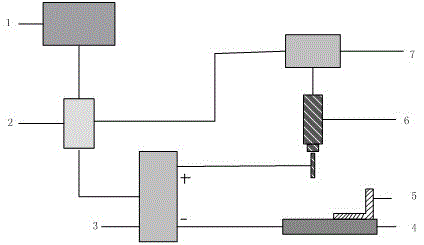A kind of preparation method of cell-containing nanofiber scaffold
A technology of nanofibers and cells, applied in medical science, prostheses, etc., can solve the problems of difficult distribution of cells, slow growth of new tissues, and low cell planting density, so as to facilitate signal transmission, adhesion, good controllability
- Summary
- Abstract
- Description
- Claims
- Application Information
AI Technical Summary
Problems solved by technology
Method used
Image
Examples
Embodiment 1
[0019] A method for preparing a cell-containing nanofiber scaffold. The nanofiber scaffold is composed of degradable polymers and cells, and is prepared at one time by electrospray technology, including the following steps:
[0020] 1) Use an electronic scale to weigh 1.76 grams of PVA particles and slowly add them to 18.24 grams of deionized water under stirring conditions. After fully swelling, heat up to about 90°C to accelerate dissolution, and keep warm for 3 hours to obtain transparent 8.8 After the %PVA solution, add 0.15 grams of β-TCP powder to mix and grind for 2 hours with a vibrating ball mill;
[0021] 2) High-temperature disinfection of the above materials at 120°C;
[0022] 3) Human adipose stem cells of passage 4 were digested with 0.25% trypsin and collected in a 50mL centrifuge tube, centrifuged at 1000 r / min for 5 min, discarded the supernatant, and transferred the cell suspension to the sterilized above materials and stirred evenly to obtain Cell-containin...
Embodiment 2
[0028] This example is basically the same as Example 1, except that: Weigh 2 grams of PEO particles with an electronic balance, slowly add them to 8 grams of deionized water under stirring, and heat up to about 60°C to accelerate dissolution after fully swelling. And keep it warm for 3 hours, after making a transparent 20% PEO solution, add 0.15 g of β-TCP powder for mixing and grind for 2 hours with a vibrating ball mill.
Embodiment 3
[0030] This example is basically the same as Example 1, except that the stem cells used in step 3) are bone marrow mesenchymal stem cells.
PUM
 Login to View More
Login to View More Abstract
Description
Claims
Application Information
 Login to View More
Login to View More - R&D
- Intellectual Property
- Life Sciences
- Materials
- Tech Scout
- Unparalleled Data Quality
- Higher Quality Content
- 60% Fewer Hallucinations
Browse by: Latest US Patents, China's latest patents, Technical Efficacy Thesaurus, Application Domain, Technology Topic, Popular Technical Reports.
© 2025 PatSnap. All rights reserved.Legal|Privacy policy|Modern Slavery Act Transparency Statement|Sitemap|About US| Contact US: help@patsnap.com

